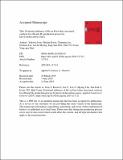Files in this item
Positional influence of Ru on Perovskite structured catalysts for efficient H2 production process by heavy-hydrocarbon source
Item metadata
| dc.contributor.author | Jeon, Yukwon | |
| dc.contributor.author | Kwon, Ohchan | |
| dc.contributor.author | Lee, Chanmin | |
| dc.contributor.author | Lee, Gicheon | |
| dc.contributor.author | Myung, Jae-ha | |
| dc.contributor.author | Sun Park, Sang | |
| dc.contributor.author | Irvine, John T. S. | |
| dc.contributor.author | Shul, Yong-gun | |
| dc.date.accessioned | 2020-06-12T23:34:51Z | |
| dc.date.available | 2020-06-12T23:34:51Z | |
| dc.date.issued | 2019-07-25 | |
| dc.identifier | 259361930 | |
| dc.identifier | f732013d-a0ba-49bd-acc3-40ddeb1d534e | |
| dc.identifier | 85067973140 | |
| dc.identifier | 000477790800021 | |
| dc.identifier.citation | Jeon , Y , Kwon , O , Lee , C , Lee , G , Myung , J , Sun Park , S , Irvine , J T S & Shul , Y 2019 , ' Positional influence of Ru on Perovskite structured catalysts for efficient H 2 production process by heavy-hydrocarbon source ' , Applied Catalysis. A, General , vol. 582 , 117111 . https://doi.org/10.1016/j.apcata.2019.117111 | en |
| dc.identifier.issn | 0926-860X | |
| dc.identifier.other | RIS: urn:480D0B64E74553E8FA05B5811DC69947 | |
| dc.identifier.other | ORCID: /0000-0002-8394-3359/work/68280754 | |
| dc.identifier.uri | https://hdl.handle.net/10023/20079 | |
| dc.description | This research was supported by the Industrial Technology Innovation Program funded by the Ministry of Trade, Industry and Energy (MOTIE), Republic of Korea (grant number 10052076). | en |
| dc.description.abstract | Direct conversion of heavy-hydrocarbon source into H2–rich gas fuels has been highlighted as an efficient ultraclean system. Dictating the productivity of the system, the most important factor lies with the activity and physical/chemical stability of the catalytic materials. In this work, perovskite hollow fiber catalysts by partial substitution of Cr with Ru in the B site for LaCrO3 (LaCr1-xRuxO3, x = 0–0.4) are designed to investigate the effects of the positional and chemical changes of Ru on the catalytic properties at autothermal reforming of heavy-hydrocarbon. From a novel synthesis method, a hollow fibrous perovskite nanoparticle network is prepared to provide high surface area. Depending on the Ru doping levels, the optimal Ru amount exists as lattice type Ru, while an excess Ru resulted in the formation of surface type Ru on the perovskite. Especially, a slight structural modification of the orthorhombic structure owing from the doped Ru results in the increase of the surface oxygen and reducibility due to the high-valanced Cr and Ru states. After autothermal reforming of heavy-hydrocarbon including sulfur, it is obvious that the mixed lattice and surface Ru type shows a large deactivation due to the strong binding energy with carbon and sulfur. In contrast, less coke formation and sulfur poisoning are revealed for the catalyst with mostly lattice type Ru through the stable Ru species and high amount of active oxygen. Consequently, the hollow perovskite fiber catalyst of LaCr0.8Ru0.2O3 displays the optimal activity to extract the highest amount of H2 from the heavy-hydrocarbon source with exceptional stability. | |
| dc.format.extent | 2280920 | |
| dc.language.iso | eng | |
| dc.relation.ispartof | Applied Catalysis. A, General | en |
| dc.subject | Perovskite catalyst | en |
| dc.subject | Ru position | en |
| dc.subject | Stability | en |
| dc.subject | H2 production | en |
| dc.subject | Coke/sulfur resistance | en |
| dc.subject | QD Chemistry | en |
| dc.subject | NDAS | en |
| dc.subject.lcc | QD | en |
| dc.title | Positional influence of Ru on Perovskite structured catalysts for efficient H2 production process by heavy-hydrocarbon source | en |
| dc.type | Journal article | en |
| dc.contributor.institution | University of St Andrews. School of Chemistry | en |
| dc.contributor.institution | University of St Andrews. Centre for Designer Quantum Materials | en |
| dc.contributor.institution | University of St Andrews. EaSTCHEM | en |
| dc.identifier.doi | https://doi.org/10.1016/j.apcata.2019.117111 | |
| dc.description.status | Peer reviewed | en |
| dc.date.embargoedUntil | 2020-06-13 |
This item appears in the following Collection(s)
Items in the St Andrews Research Repository are protected by copyright, with all rights reserved, unless otherwise indicated.

